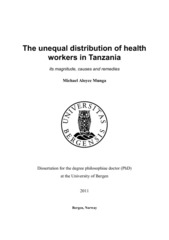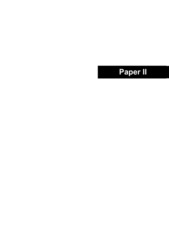| dc.contributor.author | Munga, Michael Aloyce | en_US |
| dc.date.accessioned | 2011-05-06T08:54:29Z | |
| dc.date.available | 2011-05-06T08:54:29Z | |
| dc.date.issued | 2011-02-04 | eng |
| dc.identifier.isbn | 978-82-308-1692-9 (print version) | en_US |
| dc.identifier.uri | https://hdl.handle.net/1956/4754 | |
| dc.description.abstract | Increasing recruitment of health workers in remotely located areas has recently become a crucial policy concern of many countries. There is currently a universal consensus that increasing access to health workers in such underserved areas will not only help countries address the imbalanced distribution of health workers but also improve the population’s health outcomes based on the values, principles and approaches of primary health care which place emphasis on universal access to quality health care services. To date, there is no comprehensive measure that will suit country specific estimation of the nature and magnitude of the problem of unequal distribution of health workers. There is some evidence emerging in many low-income countries on what determines health workers’ practice location choices. The importance of financial and non-financial interventions in attracting health workers to work in underserved remote areas of many countries has been extensively documented. However, there is lack of evidence on the effectiveness of financial and non-financial interventions that countries can implement to increase the share of health workers in underserved areas and thus reverse the growing trend of unequal distribution of health workers. There is also a huge body of literature on health sector reforms and particularly decentralisation but very little is known about the implications of these reforms for recruitment and distribution of health workers in remotely located areas. In the light of these aspects, the present PhD research aimed to accomplish three objectives. The first was to describe the nature and magnitude of the problem, suggest and apply additional needs indicators in order to provide more sensible indicators of health care needs for the comprehensive measurement of the magnitude of distributional inequalities of health workforce in a resource limited setting (Paper I). The second objective was to describe and assess the organization of the recruitment processes (decentralised vs centralised) in relation to their implications for distribution and retention of health workers in remotely located health facilities of Tanzania (Paper II). The final objective was to analyse how strongly financial and nonfinancial incentives (housing and education) might affect health workers willingness to work in remote areas of Tanzania, and how strongly the level of financial incentives needed to attract health workers to work in remote areas is affected by health workers characteristics such as geographic origin, their intrinsic motivation and other personal characteristics (Paper III). The details of methodology regarding sampling, data collection and analysis are described in the respective papers attached in this thesis. In Paper I the main finding indicates that there exist huge inequalities in the distribution of health workers between urban and rural districts of Tanzania. Inequalities are perceptible both when the conventional per capita norm is used and when under five mortality is used as an additional indicator of need. There are also skill- mix inequalities indicating that districts with fewer health workers per capita do also tend to have a fewer number of highly trained health workers such as doctors and specialists. Inequalities are also perceptible across urban and rural districts. Distributional inequalities tend to be more pronounced when under-five deaths are used as an indicator of health care needs. Conversely, if health care needs are measured by HIV prevalence, the distributional inequalities tend to decline. In Paper II it was shown that recruitment of health workers under a decentralised arrangement is characterised by complex and bureaucratic procedures, severe delays and sometimes failure to recruit the required health workers. This may further aggravate the existing inequalities in the distribution of health workers. The paper further indicates that recruitment of highly trained health workers in remote areas might not only be difficult but also expensive. In addition, decentralised recruitment was perceived to be more effective in recruiting and retaining lower cadre health workers from within the districts than the centralised recruitment arrangement. Conversely, centralised recruitment was perceived to be more effective (than decentralised recruitment procedures) in both recruiting highly skilled workers and balancing their distribution across remote and urban districts but not as effective in ensuring their retention. Results from Paper III indicate that, without any interventions, 19% of nurses were willing to work in remote places. With provision of free housing, this share increased by 15 percentage points, while better education opportunities increased the share by 28 percentage points from the baseline. In order for a salary top up to have the same effect as provision of free housing, the top up needed to be between 80% and 100% of the base salary. Similarly, for salary top ups to have the same effect as provision of better education opportunities the top up needed to be between 120% and 140%. Nurses who have a very remote origin (i.e. his/her origin being more remote than the remoteness of the expected working place) had on average a 55 % (p<0.005) lower reservation wage than others. This finding might suggest two things. Firstly, students with a strong remote background are more willing to work in remote areas than others. Secondly, students need to be picked from really remote places (more remote than the place that policy makers may want to send them) in order for this variable to have an impact on the reservation wage. Those classified with high intrinsic motivation had on average a 30% (p<0.000) lower reservation wage than others. Having children was not significantly associated with the reservation wage, while having dependants other than children was associated with an 18% (p<0.06) increase in the reservation wage. The data presented in this thesis permits a number of conclusions. Firstly, relying solely on the conventional ways (using the per capita norm) of measuring imbalances tends to lead one into missing out a lot of relevant information for a comprehensive and a sensible estimate of the magnitude of the inequalities in the distribution of health workers. Population levels, although still useful as an indicator of health care needs in measuring distributional imbalances, is flawed for it makes the inherent assumption that disease burdens and thus health care needs are uniformly distributed. This is not the case in many settings (Paper I). Secondly, since the recruitment systems (decentralised or centralised) have been shown to be a crucial factor that can hinder or facilitate the recruitment of health workers in underserved remote areas, combining the strengths of each system seem to add to the efforts of increasing recruitment of health workers in remotely located health facilities (Paper II). Finally, the thesis concludes that nurses’ practice- location decisions in Tanzania are partly shaped by the effects of financial and nonfinancial incentives. Specific educational interventions are more effective in attracting nurses to remote areas than housing. Substantial top ups are needed in order for the salary factor to have the same effect as alternative interventions. In order for remote recruitment to be effective in reducing the need for incentives to attract nurses to remote areas, health workers need to be recruited from places that are more remote than the places supposed to be their work stations. | en_US |
| dc.language.iso | eng | eng |
| dc.publisher | The University of Bergen | eng |
| dc.relation.haspart | Paper I: Human Resources for Health 7(4), Munga, M. A.; Mæstad, O., Measuring inequalities in the distribution of health workers: the case of Tanzania. Copyright 2009 Munga and Mæstad; licensee BioMed Central. Reproduced with permission. Published version. The published version is also available at: <a href="http://dx.doi.org/10.1186/1478-4491-7-4" target="_blank">http://dx.doi.org/10.1186/1478-4491-7-4</a> | en_US |
| dc.relation.haspart | Paper II: BMC International Health and Human Rights 9(9), Munga, M. A.; Songstad, N. G.; Blystad, A.; Mæstad, O., The decentralisation-centralisation dilemma: recruitment and distribution of health workers in remote districts of Tanzania. Copyright 2009 Munga and Mæstad; licensee BioMed Central. Reproduced with permission. Published version. The published version is also available at: <a href="http://dx.doi.org/10.1186/1472-698X-9-9" target="_blank">http://dx.doi.org/10.1186/1472-698X-9-9</a> | en_US |
| dc.relation.haspart | Paper III: Munga, M. A.; Torsvik, G.; Mæstad, O., 2011, The effectiveness of financial and nonfinancial interventions in attracting nurses to remote areas of Tanzania: a contingent valuation study. Submitted version. Full text not available in BORA. | en_US |
| dc.title | The unequal distribution of health workers in Tanzania. Its magnitude, causes and remedies | en_US |
| dc.type | Doctoral thesis | |
| dc.rights.holder | Copyright the author. All rights reserved | |
| dc.rights.holder | The author | |
| dc.subject.nsi | VDP::Medical disciplines: 700::Health sciences: 800::Community medicine, Social medicine: 801 | eng |



